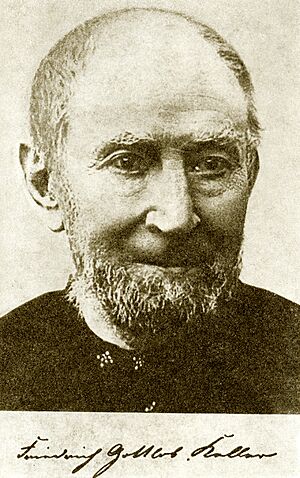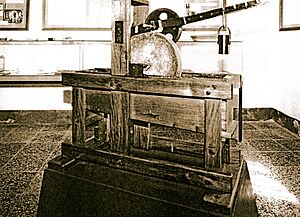Friedrich Gottlob Keller facts for kids
Quick facts for kids
Friedrich Gottlob Keller
|
|
|---|---|
 |
|
| Born | 27 June 1816 Hainichen, Saxony
|
| Died | 8 November 1895 (aged 79) Krippen, Saxony
|
| Nationality | German |
| Occupation | mechanic, machinist, binder, inventor |
| Known for | The invention of wood pulp for the production of paper |
| Awards | "Merit of Invention" by the German Government for his invention of the wood-cut machine for making pulp wood |
Friedrich Gottlob Keller (born June 27, 1816 – died September 8, 1895) was a German machinist and inventor. A machinist is someone who builds or repairs machines. Keller is famous for inventing the process of making wood pulp. This wood pulp is used to make paper. He came up with this idea at the same time as Charles Fenerty. Keller also created a special machine to cut wood and get the fibers needed for pulp. Unlike Fenerty, Keller got a patent for his invention.
Early Life and Big Ideas
Friedrich Gottlob Keller grew up in Hainichen, Saxony, a town in north-eastern Germany. As a child and young man, he worked with his father. They were weavers, making fabric, and also made parts for looms called heddles. But Keller wasn't happy with this job. He was much more interested in machines.
Keller always carried an "idea-book" with him. In this book, he would write down his thoughts about different machines. He loved to read about machines and was very knowledgeable about how they worked. Later in life, he remembered reading an article about a French scientist named René Antoine Ferchault de Réaumur. Réaumur had wondered if paper could be made from trees. He never tried it himself, but the idea stuck with Keller. In 1841, when he was 25, Keller wrote down his own ideas for a machine. This machine would cut wood and pull out the fibers needed to make paper pulp.
Keller's Amazing Invention
Before Keller's invention, most paper was made from old rags. Rags were hard to find in large amounts. In the 1700s, René Antoine Ferchault de Réaumur suggested using trees for paper. Another person, Matthias Koops, even published a book in 1800 with covers made from trees. But his method was different; he just ground the wood into particles. He didn't make wood pulp like Keller.
Starting in 1841, Keller worked very hard on his wood-cutting machine. He had spent years trying to invent different machines. But this wood-cut machine became his main focus. He worked on it for three years, from 1841 to 1844. In 1844, he finished his machine. He successfully made a piece of paper from wood pulp using his invention.
In the summer of 1844, Keller sent a sample of his paper to the German government. He hoped to get money to improve his machine and make more paper. But he didn't get any support. Interestingly, Charles Fenerty in Canada also discovered how to make wood-based paper around the same time. Both inventors found that no one was interested in their discoveries at first.
Keller didn't give up. Since he couldn't get government help, he sold his invention. He sold it to a paper expert named Heinrich Voelter for about £80. In August 1845, a patent was given in both their names in Saxony, Germany. A patent is a special right that protects an invention. Voelter then started making the wood pulp on a large scale.
At first, Voelter needed Keller because only Keller knew how to build the wood-grinding machine. But this changed. After 1848, the first machines were built. In 1852, it was time to renew the patent. Keller didn't have enough money to renew his part of the patent. So, Voelter became the only patent holder. He continued the work and made a lot of money, but Keller didn't get any of it.
Later Years and Recognition
Heinrich Voelter kept the patent for the wood-grinding machine. This left Keller without a job and without money. However, the wood-grinding machine was a huge success. Voelter sold many of them across Europe and America. By 1852, paper made from ground wood pulp was being produced regularly. The "Frankenberger Intelligence and Weekly" newspaper in Saxony, Germany, was the first to use Keller's invention for newsprint.
It took about twenty years for newspapers and book printers to fully switch to wood pulp. But by the 1860s, the new process became very popular. By the end of the 1800s, very few printers in the Western world still used rags for paper. Most had switched to wood.
Throughout his life, Keller didn't receive any money from his invention. However, in 1870, some German paper makers and other groups collected money for him. He used this money to buy a house in Krippen, Germany. Towards the end of his life, more money was collected for him from different countries. This was enough for him to have a comfortable retirement. He also received several awards for his important invention.
See also


